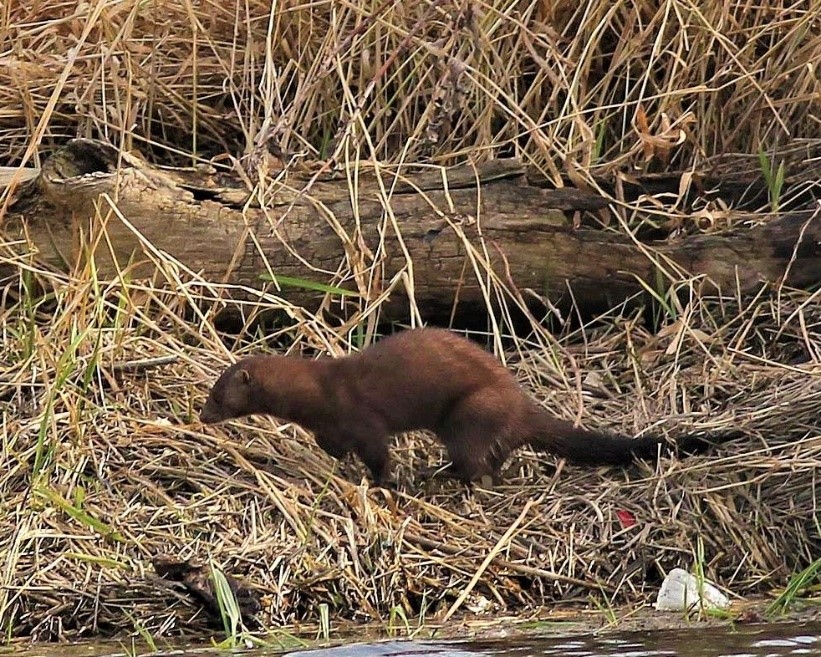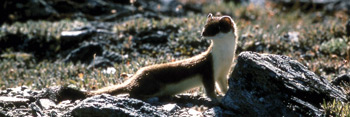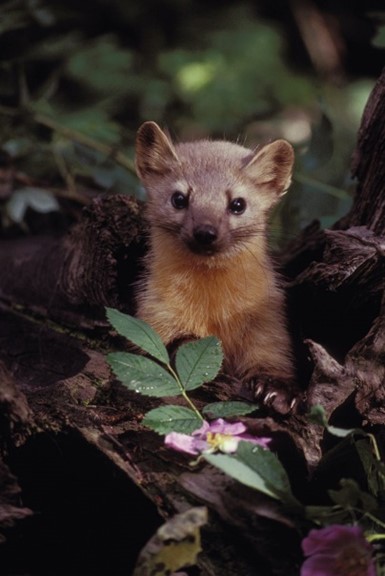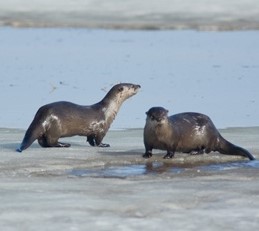American Mink (Neovison vison)

Infrequently seen, Mink are large, dark brown weasels that are found in or near water, especially beaver ponds. Adult males can measure up to 24 inches and weigh up to 3 ½ pounds. Mink’s blackish tails are shorter than half the length of their bodies. MInk take over deserted burrows and dens of other animals for their own, or will occasionally den in hollow trees. Ferocious killers, they eat muskrats, beaver kits, nestling waterfowl, frogs, salamanders, fish, crayfish and insects. They often kill more than they can eat and store the leftovers.
For more information about mink go to: Mink (Minnesota Mammals)
Ermine or Short-tailed Weasel and Long-tailed Weasel (Mustela erminea and Mustela frenata)


Similar in appearance and behavior, Ermine and Long-tailed Weasels are difficult to tell apart. It doesn’t help that both of these small weasels change color from brown to white in winter, when they are both commonly called Ermine. Ermine are also called Short-tailed weasels or Stoats.
Long-tailed weasels, the larger of the two, are 7-13 inches long and weigh up to 5 ounces. Ermine average 6-8 inches in length and weigh only 1-2 ounces. The Long-tailed weasel’s tail is approximately half again the length of its body while the Ermine’s tail is approximately a third the length of its body. Both have black tips on their tails, but the Ermine’s is much more pronounced. both animals are chocolate brown in the summer, but the Ermine’s tummy is white, and the weasel’s is yellowish to orange.
To learn more about Ermine and Long-tailed weasels, go to: Ermine Or Short-Tailed Weasel (Amerian Society of Mammalogists)
Also worth knowing: White fur, no matter what animal it comes from, is called “ermine.”
Marten (Martes americanus)

Martens, also called Pine Martens or American Martens, are large forest weasels. Adult males may measure up to 2 ½ feet long and weigh as much as 2 pounds; adult females are smaller. Martens are brown on top and pale yellowish brown beneath. Mostly nocturnal, they will also hunt during the day. They eat mice, squirrels, birds, insects and even seeds and berries. They don’t hibernate but during very cold weather they may “den up” in a hollow tree trunk or an old squirrel’s nest.
For more information about Martens go to: Marten (Clear Creek County)
Also Worth Knowing
Four other weasels are found in Colorado:

- Blackfooted Ferrets (Mustela nigripes) have twice been thought to be extinct. Remarkably, a small population was discovered in 1981 in Wyoming. They are now being reestablished, thanks to conservation efforts including captive breeding programs and wild relocations. Learn more about Black Footed Ferrets and why their survival is so important at Black-Footed Ferret (Colorado Parks and Wildlife)
- Badgers (Taxidea taxus) and Wolverines (Gulo gulo), are not likely to be seen but may be present in the wilderness areas of the watershed.
- River Otters, (Lontra Canadensis), were once abundant in Colorado. They are not found in the Bear Creek watershed now, but they are making a comeback in other parts of the state.
To learn how to tell the difference between otters, beavers, and muskrats, go to: Species Profiles (Colorado Parks and Wildlife)
For more information about all the members of the weasel family, go to: Weasels (Montana Field Guide)